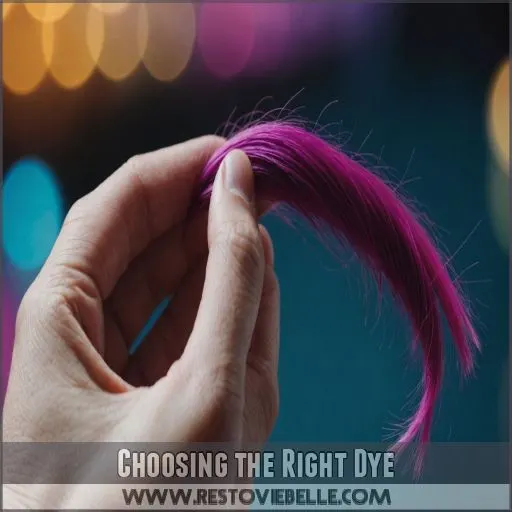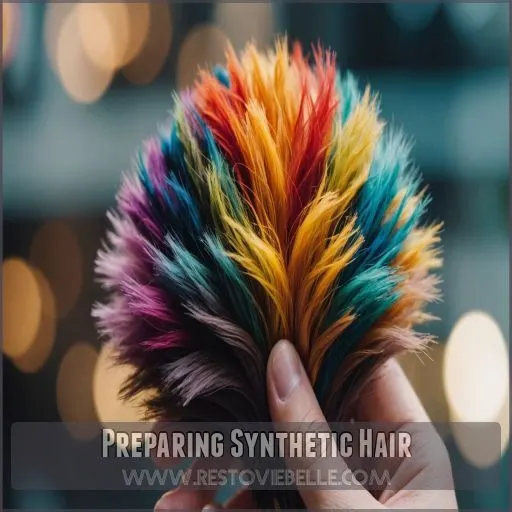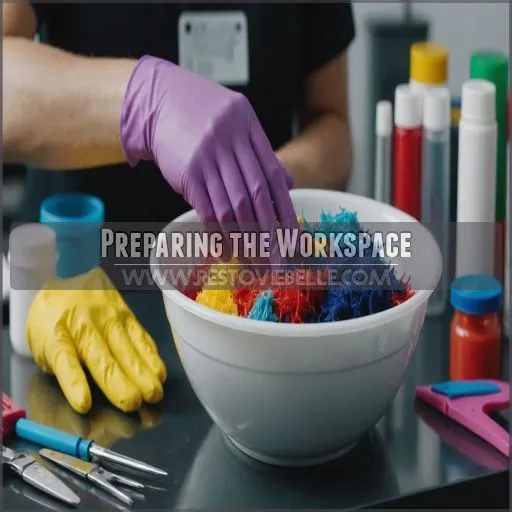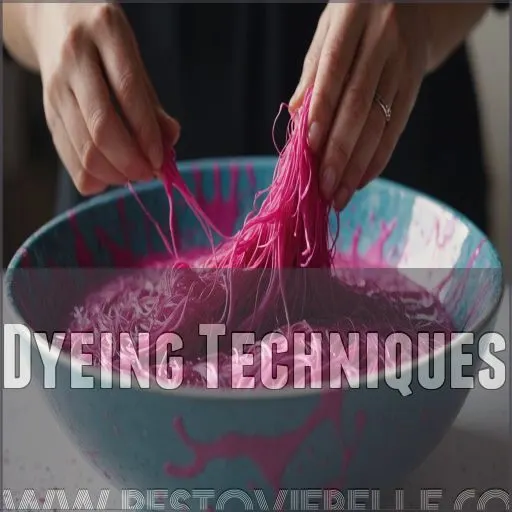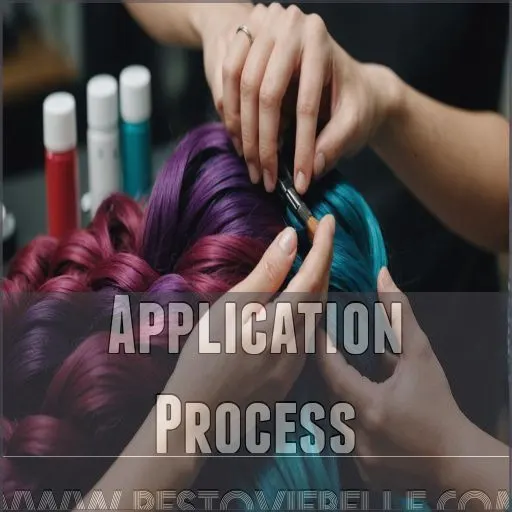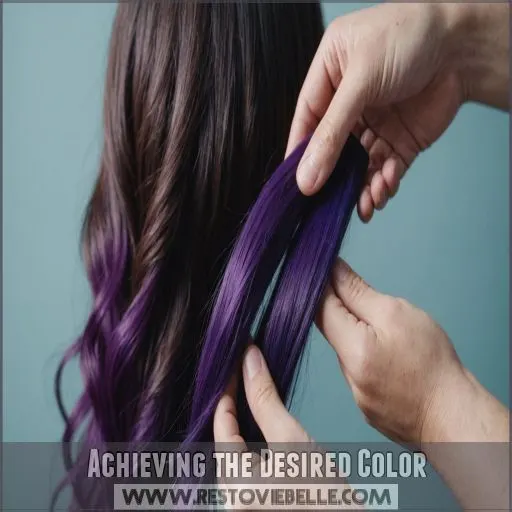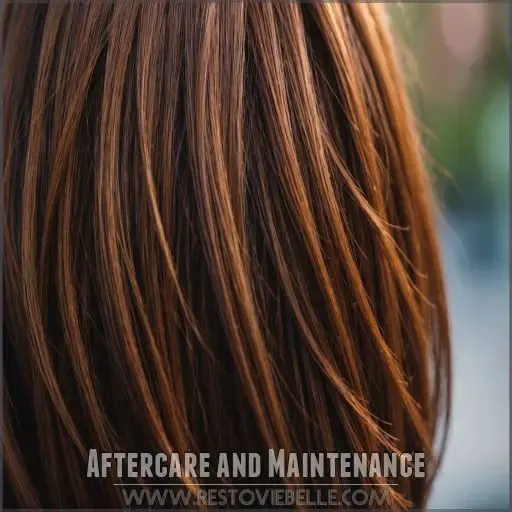This site is supported by our readers. We may earn a commission, at no cost to you, if you purchase through links.
 Yes, you can dye synthetic hair, but it’s a bit like cooking a soufflé—tricky, yet doable! Regular hair dyes are a no-go; they’ll leave you with a wig disaster.
Yes, you can dye synthetic hair, but it’s a bit like cooking a soufflé—tricky, yet doable! Regular hair dyes are a no-go; they’ll leave you with a wig disaster.
Instead, grab fabric dyes like Rit DyeMore, which work wonders on synthetic fibers.
Before you channel your inner Picasso, wash, condition, and detangle the hair thoroughly—trust me, you’ll thank me later. And don’t forget to protect your workspace unless you’re redecorating your floors!
There are some cool tricks up the sleeve, like using acrylic paint or marker ink for epic color transformations. Curious for more tips and techniques? Keep reading!
Table Of Contents
- Key Takeaways
- Choosing the Right Dye
- Preparing Synthetic Hair
- Preparing the Workspace
- Dyeing Techniques
- Application Process
- Achieving the Desired Color
- Aftercare and Maintenance
- Safety Precautions and Tips
- Frequently Asked Questions (FAQs)
- What dye can I use to dye synthetic hair?
- Can you change the color of synthetic hair?
- Can you semi permanently dye synthetic hair?
- Does Splat hair dye work on synthetic hair?
- Can I use home ingredients like food coloring or coffee to dye synthetic hair?
- How many times can you dye synthetic hair?
- Can you re-dye synthetic hair if you dont like the first result?
- Will dyeing synthetic hair shorten its lifespan?
- How can you color synthetic hair without staining the lace?
- Conclusion
Key Takeaways
- You can definitely dye synthetic hair, but it’s not as simple as grabbing any old hair dye. Stick to fabric dyes like Rit DyeMore, or try unique methods using acrylic paint or marker ink to get vibrant results.
- Always prep your synthetic hair before dyeing—think of it as warming up before a big game. Wash, condition, and detangle it for a smoother coloring process, and be sure to perform a strand test to avoid any hair-raising surprises.
- Protect your surroundings and yourself! Cover your workspace and wear gloves and old clothes, or your favorite shirt might end up looking like it belongs in a paintball arena.
- Experiment with different colors and techniques like ombre or dip dye to achieve your dream look. Remember, patience is key to avoid shades that fade faster than yesterday’s milk.
Choosing the Right Dye
When you’re ready to dye synthetic hair, figuring out what dye works best can be as confusing as a seven-legged octopus trying to fit in a five-legged race.
We’ll walk you through essential tips on choosing the right dye and key ingredients to look out for, ensuring your synthetic hair color turns out amazing.
Available Dye Options for Synthetic Hair
So, you’re wondering how to dye synthetic hair? Well, buckle up! Options abound. Fabric dye brands like Rit DyeMore or even Sharpie dyeing can add life to your wig.
If you’re artsy, try airbrushing techniques for colorful flair.
Remember, though, synthetic hair dye options have limitations. Think about colorfastness properties. Embrace control, explore possibilities, and watch your synthetic wig transform!
Key Ingredients to Consider
When choosing the right dye for your synthetic hair, consider key ingredients that can make all the difference.
Opt for fabric dyes or dyes specifically formulated for synthetic materials – they’ll bond better with the fibers and deliver more vibrant, long-lasting color without compromising the integrity of your hairpiece.
Steer clear of regular hair dye, which can damage those delicate synthetic strands.
Preparing Synthetic Hair
Before you start dyeing synthetic hair, give it a good wash and condition to make sure it’s nice and clean—like prepping a canvas for a masterpiece.
Also, hair that’s as smooth as silk is what you want, so detangle those knots and do a quick strand test to avoid any hair disasters.
Washing and Conditioning Before Dyeing
Before dyeing your synthetic hair, get ready for pre-dye prep like a pro!
Wash with shampoo designed for synthetic fibers—it’s like giving your wig a spa day.
Conditioner isn’t just pampering; it strengthens those hair extensions for dyeing.
Think of it as readying a canvas.
Trust me, your synthetic hair types will thank you with sleek style and vibrancy!
Removing Tangles and Knots
Getting rid of tangles in synthetic hair is like untangling a mystery!
Use a wide-tooth comb and detangling spray to make the job easy-peasy.
A knot remover can be your secret weapon.
Avoid tight brushes; handle the hair gently, like you’re cradling a baby squirrel.
Remember, synthetic wigs and hair extensions need a little extra TLC before dyeing.
Performing a Strand Test
You’ll want to do a strand test before dyeing your synthetic hair, just like you would before dyeing bleached hair.
This helps you see how the dye reacts and whether it’ll damage your hairpiece.
Just pick a small, hidden section and follow the dyeing process.
Check the color intensity and how the strands hold up.
This way, you can avoid any nasty surprises down the line.
Preparing the Workspace
Before you start dyeing your synthetic hair, set up your workspace like you’re planning a colorful science project—minus the volcano eruption, hopefully!
Grab some old newspapers or plastic tarps to protect your surfaces from stains
and don your best "mad scientist" gloves and apron to avoid turning yourself into a walking art piece.
Protecting Surfaces From Stains
Dyeing synthetic hair can get messy! To save your sanity—and your surfaces—lay down newspaper or plastic where you’ll be working.
Acrylic paint, fabric dye, and alcohol-based ink know how to party, but your furniture doesn’t!
Consider this as your workspace’s raincoat; it keeps stains at bay. A little prep here and you’ll avoid channeling your inner Jackson Pollock.
Wearing Protective Gear
Slay that synthetic wig color makeover, but don’t forget the protective gear! When you’re playing with dye potions, make sure:
- Gloves: Keep hands safe from stains.
- Apron: Defend your clothes from pesky splatters.
- Masks: Avoid inhaling fumes—trust me, not fab.
- Eye Protection: Shield those peepers, because nobody likes surprises!
Safeguard your workspace protection, because spills always have excellent aim!
Choosing the Right Tools and Equipment
Gather the right tools and set up your workspace for a smooth dyeing experience.
Protect your surfaces with newspaper or plastic tarps to avoid stains.
Grab a wide-tooth comb, spray bottle, and synthetic hair conditioner.
Don’t forget your trusty latex gloves – they’ll keep your hands clean and safe throughout the process.
Dyeing Techniques
You’re about to get creative with your synthetic hair, using tools like fabric dye, acrylic paint, or even permanent marker ink.
Let’s see how these methods can transform your wig without turning your home into a dye disaster zone!
Fabric Dye Method
To dye synthetic hair with fabric dye, start with a dye bath at the right temperature, just like Goldilocks—neither too hot nor too cold.
Consider popular fabric dye brands to make sure you get vibrant results while avoiding hair damage.
Submerge your heat-friendly synthetic hair, keeping an eye on soaking time, or you might find color fading faster than you’d like!
Rit DyeMore Method
Ready to shake things up beyond fabric dye? Enter the Rit DyeMore method, where color vibrancy meets synthetic hair flair!
Start by heating water—hot enough to make your hair sing. Add Rit DyeMore for luscious options. Submerge damp hair for a custom color.
Compared to fabric dye, expect longer-lasting hues and synthetic hair maintenance that’s second nature, like washing with fabric softener.
Acrylic Paint Method
If you’re feeling creative, the acrylic paint method is a fun way to dye your synthetic hair.
Simply dilute the paint with rubbing alcohol, then spray the mixture onto the hairpiece and work it through the strands.
Just be mindful of drying time – you don’t want any drippy, gloppy results!
With a little experimentation, you can mix colors to achieve your desired shade.
The best part? Acrylic paint can give your synthetic locks a vibrant, long-lasting hue, perfect for themed parties or Halloween costumes.
Permanent Marker Ink Method
Ever thought about using permanent markers to spice up your synthetic hair? It’s a colorful adventure! Here’s a quick breakdown:
- Ink Types: Use alcohol-based marker ink, like Sharpies.
- Marker Selection: Pick vibrant colors, like the blue hair colors you see in these top shampoos.
- Alcohol Ratio: Mix ink with rubbing alcohol; a 1:1 ratio works.
- Color Blending: Combine shades for unique hues.
- Dye Longevity: Not as long-lasting as with human hair extensions, but still fun!
Alcohol-Based Ink Method
From turning permanent marker ink into shades worthy of a canvas, you’ve got another ace up your sleeve: alcohol-based ink.
Mix it in a 1:1 ratio with water, spray with style, and voilà, you’ve added flair to synthetic locks!
Ink dilution keeps colors vibrant yet gentle.
Remember, drying time keeps things shipshape.
Frequent compliments? Practically guaranteed!
Food Coloring Method
Craving vibrant locks without breaking the bank? Food coloring’s your new best friend! It might sound kooky, but it works wonders:
- Mix food coloring with hair mousse.
- Apply the vibrant concoction to the hairpiece.
- Let the colors mingle for 30 minutes.
- Rinse for surprising color longevity.
- Expect some fading over time.
Unleash your inner artist and paint the town!
Application Process
Dyeing synthetic hair is a straightforward process, but it requires a bit of care and attention.
Start by sectioning your hairpiece into manageable chunks, then apply the dye evenly from roots to ends, working it in gently with your fingers for a flawless finish.
Sectioning the Hair
Now that you’re familiar with the dyeing techniques, let’s talk about sectioning the hair. Think of this step as organizing a messy closet—tactical and rewarding. Use sectioning tools like clips or ties to divide your synthetic locks into zones. This makes sure even dye distribution and avoids tangles. Check the hair sectioning tips below for smooth sailing!
| Tip | Description |
|---|---|
| Use clips | Hold hair sections in place |
| Work in small zones | Focused, accurate application |
| Comb through gently | Prevent tangles |
| Make sure even layers | Consistent color spread |
| Avoid tight bundles | Allow dye to cover each strand |
Applying the Dye
When it’s time to apply the dye, think of yourself as an artist with a colorful palette. Use small, manageable sections for even dye distribution and optimum dye saturation. Here’s a quick list for smooth sailing:
- Remember, dyeing techniques vary.
- Achieve color blending with patience.
- Apply evenly to all hair sections.
- Avoid drips and splatters—cover everything!
Dyeing techniques vary, so be sure to follow the instructions carefully.
Working the Dye Into the Hair
You’ve sectioned the hair, and now it’s time to work the dye in. Use your fingers like a master painter, ensuring even color distribution.
Focus on the roots, then comb through for saturation perfection.
Think of it as a gentle massage, not a tug-of-war. Each stroke should whisper "care."
Dyeing techniques require patience, not haste.
Achieving the Desired Color
Dyeing synthetic hair can be a fun way to experiment with new colors, but getting the perfect shade takes a bit of trial and error.
Don’t be afraid to mix and match dyes to achieve your desired look – just be sure to do a patch test first to avoid any unwanted surprises.
Mixing Colors to Achieve the Desired Shade
So, you’re ready to be a color maestro with your synthetic hair! Mixing colors to achieve the perfect shade is like painting a masterpiece. Use the color wheel to guide your choices and experiment with:
- Mixing Ratios: Balance colors effectively.
- Color Blending: Achieve seamless changes.
- Color Depth: Add dimension for a natural look.
Gradual Color Effects
| Style | Description |
|---|---|
| Ombre | Fading from dark to light shades |
| Dip Dye | Colored tips, distinct fashion |
| Balayage | Subtle hand-painted highlights |
| Color Melting | Seamlessly merges varied hues |
Create a masterpiece that dances through colors!
Color Intensity and Saturation
As you experiment with color variations to achieve your desired shade, remember that dye concentration plays a huge role in color depth.
Go bold with a splash of hue, but don’t let it fade faster than a sneeze on a windy day!
To prevent color fading, stick to dyeing processes that promise long-lasting vibrancy and maintain your masterpiece by using gentle shampoos.
Aftercare and Maintenance
After dyeing your synthetic hair, it’s really important to rinse and condition it thoroughly to keep it looking its best.
Excessive heat styling can damage those delicate fibers, so it’s best to let your ‘do air dry whenever possible.
Rinsing and Conditioning the Hair
Imagine your synthetic hair is a sponge that loves water! Rinse it under cool water until clear, then apply conditioner made for synthetic hair—no fancy spa treatments needed.
Use gentle detangling techniques like you’d stroke a pet, and skip the tug-of-war.
Keep your hair drying naturally.
Remember, good TLC helps your wig stay fabulous and drama-free!
Avoiding Excessive Heat Styling
If you’re looking after your synthetic hair, don’t risk it getting hot under the collar.
Avoid heat-styling damage by embracing cool styling tips.
Air drying is your best bet, and if you’re craving curls, try heatless curls overnight.
Treat synthetic hair like a delicate flower—keep it away from excessive heat and enjoy a long-lasting, fabulous look!
Safety Precautions and Tips
Before dyeing your synthetic wig, don’t skip the strand test—unless you’re into unexpected surprises and muddled colors.
Wear old clothes and protective gear to avoid looking like a painter’s palette after an art project gone wild.
Conducting a Strand Test Before Dyeing
Before you start dyeing your synthetic hair, it’s important to perform a strand test. This will help you see how the dye reacts with the fibers, prevent damage, and make sure the color turns out as expected.
Simply dye a small section, let it dry, and inspect the results.
This quick check can save you from a dye disaster!
Avoiding Over-Dyeing
Got that strand test nailed? Great! Now, avoid the siren song of over-dyeing. Trust the process; don’t rush dyeing time, or you’ll end up with colors bright enough for a circus.
Focus on dye saturation evenly for color uniformity. Aim for the right color depth without trying to outdo a peacock’s plume.
Patience, my friend, is your best ally!
Using Protective Gear and Clothing
After tackling over-dyeing issues, let’s focus on staying stain-free and stylish! Protect yourself with simple steps:
- Glove types: Wear latex or nitrile to keep hands clean.
- Stain removal: Old clothes or an apron guard against spills.
- Clothing choices: Dress in dark colors.
- Workspace protection: Cover surfaces with newspapers or plastic tarps.
Stay smart, dye safely!
Frequently Asked Questions (FAQs)
What dye can I use to dye synthetic hair?
To dye synthetic hair, use fabric dyes like Rit DyeMore, or get creative with acrylic paint, marker ink, or alcohol-based inks.
Regular hair dye won’t work—think outside the box and let your artistic side shine!
Can you change the color of synthetic hair?
Sure, you can dye synthetic hair using alternatives like fabric dye, food coloring, or alcohol-based ink.
While it won’t be a cakewalk due to the hair’s nature, patience and proper technique can lead to vibrant results.
Can you semi permanently dye synthetic hair?
You can semi-permanently dye synthetic hair using fabric dyes or alcohol-based inks.
Just know you’re swimming upstream; results may vary.
Always start with a strand test, like a mad scientist experimenting in their colorful lab.
Does Splat hair dye work on synthetic hair?
Splat hair dye may not be your best bet for synthetic strands – it’s formulated for natural hair and could leave your faux mane looking more like a hot mess than a haute coiffure.
Stick to dyes designed specifically for synthetic fibers for the best results.
Can I use home ingredients like food coloring or coffee to dye synthetic hair?
Using home ingredients like food coloring can add a splash of color to synthetic hair—think of it as a crafty experiment.
While results might be less predictable or vibrant, it’s a fun, budget-friendly option!
How many times can you dye synthetic hair?
Imagine you’re painting a masterpiece on tissue paper—delicate and prone to tearing.
Dye synthetic hair sparingly, as it weakens fibers.
Aim for once or twice, tops, to maintain its flowy, fake-yet-flattering charm.
Can you re-dye synthetic hair if you dont like the first result?
Got a dye job on your synthetic hair that’s not quite your cup of tea?
Good news—you can re-dye it!
Just use alcohol-based or acrylic inks, ensuring the new color is darker than the original shade (Source).
Will dyeing synthetic hair shorten its lifespan?
When life gives you lemons, make lemonade!
Dyeing synthetic hair can shorten its lifespan.
With the right techniques and products, you can breathe new life into your hairpiece without compromising its longevity.
Just take it slow and steady.
How can you color synthetic hair without staining the lace?
To color synthetic hair without staining the lace, first, turn the wig inside out and apply Vaseline to the lace.
Use a toothbrush to apply dye carefully, focusing on the roots while avoiding the lace area (Source).
Conclusion
Like mastering a tricky dance move, knowing the best methods to dye synthetic hair means you can transform wigs with flair and finesse.
Can you dye synthetic hair? Absolutely! Just choose the right materials like fabric dye or alcohol-based ink.
Remember, it’s all about preparation, protection, and experimentation.
By following these guidelines, you’ll achieve vibrant results while keeping your synthetic strands looking fresh and fabulous.
So get creative, stay curious, and enjoy your hair transformation adventure!

